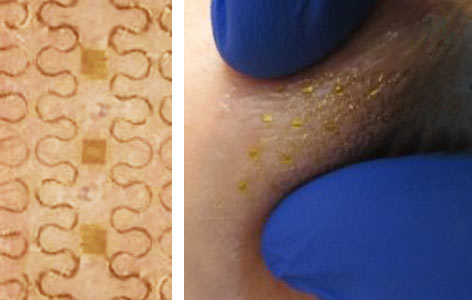Home page Description:
Creating made-to-order electronic skin that can respond to touch and pressure.
Posted On: June 15, 2016

Image Caption:
E-skins are wearable technology that can be stretched and pinched like normal skin (pictured, right panel; magnified view, left panel).
Electronic skins (e-skins) are thin, stretchable materials that mimic certain properties of human skin. They enable direct communication between the body and a computer, making them ideally suited for use in prosthetics or health monitoring devices. Emulating the sensation of touch with e-skins, however, is difficult. The natural sensation of touch involves pressure sensors on the skin; these sensors translate information about physical contact into electrical nerve impulses that travel to the brain. Designing and fabricating a material that mimics this process remains a challenge.
To help simplify the e-skin design process, TRI Affiliate Scientist Dr. Hani Naguib initiated a study with PhD candidate Nazanin Khalili to define key factors that control the ability of e-skin to mimic the behaviour of real skin. His team did this by mixing substances with complementary functions: hydrogels (water-based gels) to recreate the texture of skin; polypyrrole to conduct electricity; and fillers to enhance the conduction of electricity.
The proportions of these compounds were varied to create different e-skins that were subsequently analyzed for electrical conductivity and ability to respond to pressure. The researchers found that, depending on the relative amounts of the three compounds, electrical conductivity and pressure-responsiveness varied greatly. These results were used to create a mathematical model to predict how specific combinations of the compounds affected the suitability of the resulting e-skin for various uses.
“By changing the amounts of different components, this flexible and stretchable e-skin could be used in a variety of applications,” says Dr. Naguib. “For example, the material could be applied to a prosthetic arm to help a person sense touch, or it could provide pressure information to a robot that is assisting with surgery.”
This work was supported by the Natural Sciences and Engineering Research Council of Canada, the Canada Foundation for Innovation, the Canada Research Chairs Program and the Toronto Rehab Foundation. Image modified from Webb et al. PLoS One. http://dx.doi.org/10.1371/journal.pone.0118131.
A constriction resistance model of conjugated polymer based piezoresistive sensors for electronic skin applications. Khalili N, Naguib HE, Kwon RH. Soft Matter. 2016 Apr 1. DOI: 10.1039/c6sm00204h [Pubmed abstract]
To help simplify the e-skin design process, TRI Affiliate Scientist Dr. Hani Naguib initiated a study with PhD candidate Nazanin Khalili to define key factors that control the ability of e-skin to mimic the behaviour of real skin. His team did this by mixing substances with complementary functions: hydrogels (water-based gels) to recreate the texture of skin; polypyrrole to conduct electricity; and fillers to enhance the conduction of electricity.
The proportions of these compounds were varied to create different e-skins that were subsequently analyzed for electrical conductivity and ability to respond to pressure. The researchers found that, depending on the relative amounts of the three compounds, electrical conductivity and pressure-responsiveness varied greatly. These results were used to create a mathematical model to predict how specific combinations of the compounds affected the suitability of the resulting e-skin for various uses.
“By changing the amounts of different components, this flexible and stretchable e-skin could be used in a variety of applications,” says Dr. Naguib. “For example, the material could be applied to a prosthetic arm to help a person sense touch, or it could provide pressure information to a robot that is assisting with surgery.”
This work was supported by the Natural Sciences and Engineering Research Council of Canada, the Canada Foundation for Innovation, the Canada Research Chairs Program and the Toronto Rehab Foundation. Image modified from Webb et al. PLoS One. http://dx.doi.org/10.1371/journal.pone.0118131.
A constriction resistance model of conjugated polymer based piezoresistive sensors for electronic skin applications. Khalili N, Naguib HE, Kwon RH. Soft Matter. 2016 Apr 1. DOI: 10.1039/c6sm00204h [Pubmed abstract]




